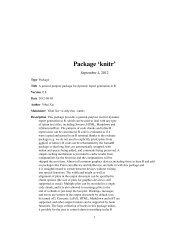Package 'openair'
Package 'openair'
Package 'openair'
Create successful ePaper yourself
Turn your PDF publications into a flip-book with our unique Google optimized e-Paper software.
114 TaylorDiagramUsageTaylorDiagram(mydata, obs = "obs", mod = "mod",group = NULL, type = "default", normalise = FALSE,cols = "brewer1", rms.col = "darkgoldenrod",cor.col = "black", arrow.lwd = 3, key = TRUE,key.title = group, key.columns = 1, key.pos = "right",strip = TRUE, auto.text = TRUE, ...)ArgumentsmydataobsmodgrouptypenormaliseA data frame minimally containing a column of observations and a column ofpredictions.A column of observations with which the predictions (mod) will be compared.A column of model predictions. Note, mod can be of length 2 i.e. two lots ofmodel predictions. If two sets of predictions are are present e.g. mod = c("base", "revised"),then arrows are shown on the Taylor Diagram which show the change in modelperformance in going from the first to the second. This is useful where, for example,there is interest in comparing how one model run compares with anotherusing different assumptions e.g. input data or model set up. See examples below.The group column is used to differentiate between different models and can bea factor or character. The total number of models compared will be equal to thenumber of unique values of group.type determines how the data are split i.e. conditioned, and then plotted. Thedefault is will produce a single plot using the entire data. Type can be one ofthe built-in types as detailed in cutData e.g. “season”, “year”, “weekday” andso on. For example, type = "season" will produce four plots — one for eachseason.It is also possible to choose type as another variable in the data frame. If thatvariable is numeric, then the data will be split into four quantiles (if possible)and labelled accordingly. If type is an existing character or factor variable, thenthose categories/levels will be used directly. This offers great flexibility for understandingthe variation of different variables and how they depend on oneanother.Type can be up length two e.g. type = c("season", "weekday") will producea 2x2 plot split by season and day of the week. Note, when two types areprovided the first forms the columns and the second the rows.Note that often it will make sense to use type = "site" when multiple sitesare available. This will ensure that each panel contains data specific to an individualsite.Should the data be normalised by dividing the standard deviation of the observations?The statistics can be normalised (and non-dimensionalised) by dividingboth the RMS difference and the standard deviation of the mod values by thestandard deviation of the observations (obs). In this case the “observed” point isplotted on the x-axis at unit distance from the origin. This makes it possible toplot statistics for different species (maybe with different units) on the same plot.The normalisation is done by each group/type combination.
















